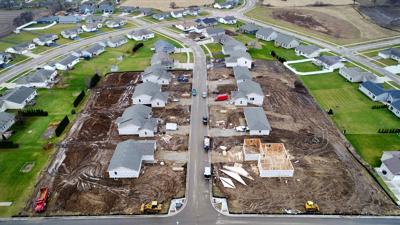JANESVILLE
The local housing market has tightened to the point that a typical ranch-style starter home might sell in the mid-$150,000 range or higher.
At least one hotel is catering to newcomers who could wait weeks or months to find an available house.
Multiple developers are pressing to build apartments at all ends of the affordability spectrum, and some residents are spending thousands of dollars on additions and renovations they hope will allow them to stay in their homes for a few more years.
A few local builders believe those phenomena are signs Janesville������Ƶ housing sector has reached a turning point in a nearly decade-long recovery after the Great Recession.
Still, one key part of the housing market—new home construction—has been sluggish to recover, at least at a rate that would keep pace with recent job growth and demand for housing.
That could change soon.
Doug Scott, a residential builder and developer who operates Amwood Homes and Advantage Homes in Janesville, predicts an uptick in new housing starts over the next two years, starting this spring.
He thinks that because his own companies plan to build 45 or 50 new homes next year—all in and around Janesville.
About half of those homes would hinge on the city annexing 20 acres of cornfield in the town of Harmony, between North Harmony Townhall Road and Huntington Avenue, Scott said. The new subdivision would bring about 43 new homes to the city������Ƶ northeast side in the next few years.
That������Ƶ in addition to housing starts Scott������Ƶ companies already have going in The Ridges, another northeast-side subdivision between Highway 26 and John Paul Road, and an idled condominium development that he plans to rekindle.
The level of home building Scott������Ƶ talking about amounts to about a 20% boost in housing starts for his own company, compared to the last few years.
If it was only Scott������Ƶ companies and no one else, the increase still would be significant. But other housing developments—most on the east side—are either in the works or in planning stages and will bring dozens more new houses in the next two years.
City officials say the local housing market has seen an average of only about 100 new homes a year over the last four or five years—less than half the average number built before the Great Recession. That has been one factor in a housing crunch that has hit Janesville harder than most other midsize Wisconsin cities.
Why? Land suitable for new homes is both relatively scarce and pricey. In addition, the cost of home building has made projects more selective. Many now are built for solidly middle-class residents looking to climb a rung or two up the property ladder.
The average cost to build a new home in Janesville this year ranges between $230,000 and $350,000, according to city construction permit applications. Sale prices are in the $280,000 to $290,000 range and up, according to a Gazette analysis of local listings for new properties.
Most new homes also average between 2,000 and 3,000 square feet—larger than a typical starter home.
Meanwhile, the average sale price for existing homes has risen steadily amid a dwindling supply—from about $155,000 in mid-2017 to about $185,000 earlier this year, according to a Gazette quarterly housing price analysis.
Scott said the narrowing gap between existing home prices and the cost of new homes has given homebuyers and builders a bigger incentive to build new.
Today������Ƶ buyers, he said, range from growing families with children to older adults who seek homes with one-floor, open layouts or large bedrooms on the first floor.
What������Ƶ different from building homes a decade ago, he said, is that lots are smaller: a half-acre or less. That������Ƶ in part because of the high cost of land.
Thus, the demand has pushed builders and developers to reactivate lots in idled subdivisions—or pay premium prices for land on the city������Ƶ outskirts to create room to spur new developments.
It������Ƶ a delicate dance, Scott said: trying to entice landowners to sell land for development and find homebuyers who’ll pay $250,000 or more for a new home. But he said the economy has seen sustained tailwinds the last two years, and more people have the money and interest in new housing developments.
“I’ve got a waiting list now for the lots we’ll be developing next spring,” he said. “So that makes me more comfortable going ahead” with other developments.
Three Roscoe, Illinois, builders have constructed more than a dozen new homes this year along Kells Way, a cul-de-sac just west of North Harmony Townhall Road. An Edgerton Realtor is listing one of those homes—a 1,400-square-foot, three-bedroom ranch—for $183,000, and the property is targeted at “first-time homebuyers or somebody looking to downsize.”
One of the Roscoe builders declined to talk about the properties, and another could not be reached.
Scott and another local builder, Brad Rein, said they’re familiar with the Roscoe builders’ development. They believe the builders plan at least 30 to 40 more homes in that subdivision over the next year or so.
Doug Marklein, a local builder and longtime city council member, said some builders are staying afloat by designing homes that are a little smaller on smaller lots—although some of the new homes have lavish or customized interiors.
Marklein said high-volume builders seem to have found a sweet spot in building homes people want to buy, despite land costs that average $35,000 per improved lot—about $10,000 more per lot than buyers would have wanted to pay 10 years ago.
Scott said he������Ƶ looking forward to a “big year” next year.








